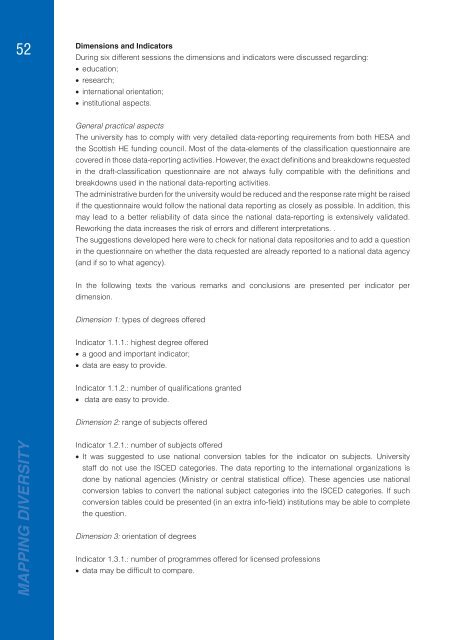Mapping Diversity: Developing a European Classification of ... - U-Map
Mapping Diversity: Developing a European Classification of ... - U-Map
Mapping Diversity: Developing a European Classification of ... - U-Map
Create successful ePaper yourself
Turn your PDF publications into a flip-book with our unique Google optimized e-Paper software.
Dimensions and Indicators<br />
52<br />
During six different sessions the dimensions and indicators were discussed regarding:<br />
• education;<br />
• research;<br />
• international orientation;<br />
• institutional aspects.<br />
General practical aspects<br />
The university has to comply with very detailed data-reporting requirements from both HESA and<br />
the Scottish HE funding council. Most <strong>of</strong> the data-elements <strong>of</strong> the classifi cation questionnaire are<br />
covered in those data-reporting activities. However, the exact defi nitions and breakdowns requested<br />
in the draft-classifi cation questionnaire are not always fully compatible with the defi nitions and<br />
breakdowns used in the national data-reporting activities.<br />
The administrative burden for the university would be reduced and the response rate might be raised<br />
if the questionnaire would follow the national data reporting as closely as possible. In addition, this<br />
may lead to a better reliability <strong>of</strong> data since the national data-reporting is extensively validated.<br />
Reworking the data increases the risk <strong>of</strong> errors and different interpretations. .<br />
The suggestions developed here were to check for national data repositories and to add a question<br />
in the questionnaire on whether the data requested are already reported to a national data agency<br />
(and if so to what agency).<br />
In the following texts the various remarks and conclusions are presented per indicator per<br />
dimension.<br />
Dimension 1: types <strong>of</strong> degrees <strong>of</strong>fered<br />
Indicator 1.1.1.: highest degree <strong>of</strong>fered<br />
• a good and important indicator;<br />
• data are easy to provide.<br />
Indicator 1.1.2.: number <strong>of</strong> qualifi cations granted<br />
• data are easy to provide.<br />
Dimension 2: range <strong>of</strong> subjects <strong>of</strong>fered<br />
MAPPING DIVERSITY<br />
Indicator 1.2.1.: number <strong>of</strong> subjects <strong>of</strong>fered<br />
• It was suggested to use national conversion tables for the indicator on subjects. University<br />
staff do not use the ISCED categories. The data reporting to the international organizations is<br />
done by national agencies (Ministry or central statistical <strong>of</strong>fi ce). These agencies use national<br />
conversion tables to convert the national subject categories into the ISCED categories. If such<br />
conversion tables could be presented (in an extra info-fi eld) institutions may be able to complete<br />
the question.<br />
Dimension 3: orientation <strong>of</strong> degrees<br />
Indicator 1.3.1.: number <strong>of</strong> programmes <strong>of</strong>fered for licensed pr<strong>of</strong>essions<br />
• data may be diffi cult to compare.

















